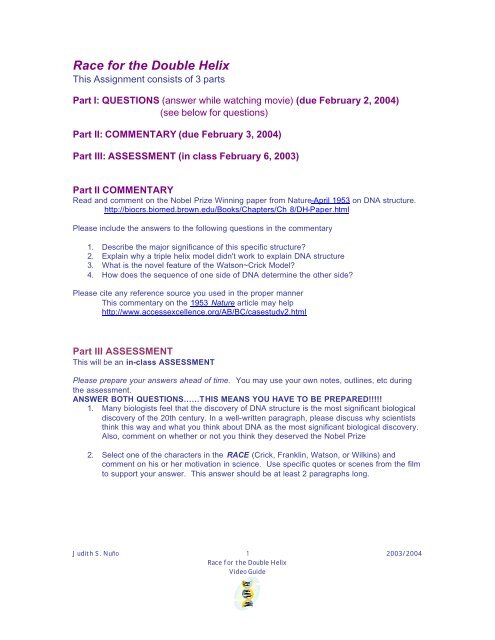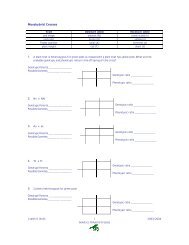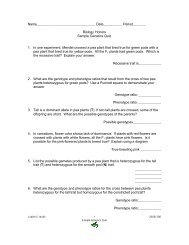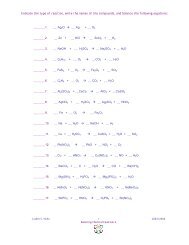Race for the Double Helix Assignment - jdenuno
Race for the Double Helix Assignment - jdenuno
Race for the Double Helix Assignment - jdenuno
You also want an ePaper? Increase the reach of your titles
YUMPU automatically turns print PDFs into web optimized ePapers that Google loves.
<strong>Race</strong> <strong>for</strong> <strong>the</strong> <strong>Double</strong> <strong>Helix</strong><br />
This <strong>Assignment</strong> consists of 3 parts<br />
Part I: QUESTIONS (answer while watching movie) (due February 2, 2004)<br />
(see below <strong>for</strong> questions)<br />
Part II: COMMENTARY (due February 3, 2004)<br />
Part III: ASSESSMENT (in class February 6, 2003)<br />
Part II COMMENTARY<br />
Read and comment on <strong>the</strong> Nobel Prize Winning paper from Nature-April 1953 on DNA structure.<br />
http://biocrs.biomed.brown.edu/Books/Chapters/Ch 8/DH-Paper.html<br />
Please include <strong>the</strong> answers to <strong>the</strong> following questions in <strong>the</strong> commentary<br />
1. Describe <strong>the</strong> major significance of this specific structure<br />
2. Explain why a triple helix model didn't work to explain DNA structure<br />
3. What is <strong>the</strong> novel feature of <strong>the</strong> Watson~Crick Model<br />
4. How does <strong>the</strong> sequence of one side of DNA determine <strong>the</strong> o<strong>the</strong>r side<br />
Please cite any reference source you used in <strong>the</strong> proper manner<br />
This commentary on <strong>the</strong> 1953 Nature article may help<br />
http://www.accessexcellence.org/AB/BC/casestudy2.html<br />
Part III ASSESSMENT<br />
This will be an in-class ASSESSMENT<br />
Please prepare your answers ahead of time. You may use your own notes, outlines, etc during<br />
<strong>the</strong> assessment.<br />
ANSWER BOTH QUESTIONS……THIS MEANS YOU HAVE TO BE PREPARED!!!!!<br />
1. Many biologists feel that <strong>the</strong> discovery of DNA structure is <strong>the</strong> most significant biological<br />
discovery of <strong>the</strong> 20th century. In a well-written paragraph, please discuss why scientists<br />
think this way and what you think about DNA as <strong>the</strong> most significant biological discovery.<br />
Also, comment on whe<strong>the</strong>r or not you think <strong>the</strong>y deserved <strong>the</strong> Nobel Prize<br />
2. Select one of <strong>the</strong> characters in <strong>the</strong> RACE (Crick, Franklin, Watson, or Wilkins) and<br />
comment on his or her motivation in science. Use specific quotes or scenes from <strong>the</strong> film<br />
to support your answer. This answer should be at least 2 paragraphs long.<br />
Judith S. Nuño 1 2003/2004<br />
<strong>Race</strong> <strong>for</strong> <strong>the</strong> <strong>Double</strong> <strong>Helix</strong><br />
Video Guide
Name ________________________________________________ Period ____ Date ________<br />
1. Who is one of <strong>the</strong> "believers"<br />
Part I Questions<br />
2. Name <strong>the</strong> bright hope.<br />
3. What is <strong>the</strong> gossip<br />
4. What are <strong>the</strong> goals, and who is goal oriented<br />
5. What is <strong>the</strong> "buried treasure" Who possesses it<br />
6. What is <strong>the</strong> "A" <strong>for</strong>m of DNA Who is working on it<br />
7. What is <strong>the</strong> "B" <strong>for</strong>m of DNA Who is working on it<br />
8. How do <strong>the</strong> scientists look at <strong>the</strong> structure of DNA<br />
9. What are <strong>the</strong> little problems<br />
10. Who are <strong>the</strong>" little boys"<br />
11. What didn't she see<br />
12. How did <strong>the</strong>y pair <strong>the</strong> bonds Were <strong>the</strong> paper cutouts of any value<br />
13. What is beautiful<br />
14. What benefits would have been achieved if everyone would have shared in<strong>for</strong>mation<br />
Judith S. Nuño 2 2003/2004<br />
<strong>Race</strong> <strong>for</strong> <strong>the</strong> <strong>Double</strong> <strong>Helix</strong><br />
Video Guide
Film Synopsis<br />
http://www.skidmore.edu/~mmarx/LS12000/helixintro.htm<br />
The film opens in 1951, when <strong>the</strong> young American biologist James D. Watson (1928- ),<br />
attending a conference in Italy, is jolted into active pursuit of <strong>the</strong> structure of DNA by an<br />
X-ray diffraction image of a DNA sample presented by <strong>the</strong> English biophysicist Maurice<br />
Wilkins. Since Wilkins’s image reveals <strong>the</strong> regularity of a crystal, Watson is convinced<br />
that DNA might be analyzed by straight<strong>for</strong>ward methods that have previously succeeded<br />
in solving <strong>the</strong> structure of o<strong>the</strong>r types of crystals. This conviction carries Watson to<br />
England, where <strong>the</strong> technique of X-ray crystallography is most advanced. However,<br />
since various attempts (including an introduction to Watson’s sister) have failed to<br />
impress Wilkins, Watson does not join Wilkins at King’s College, London, but instead<br />
goes to Cambridge University, where he teams up with Francis Crick (1916- ), ano<strong>the</strong>r<br />
physicist who has turned his attention to problems in biology. The Cavendish Laboratory<br />
at Cambridge, where Watson and Crick work, is headed by Sir Lawrence Bragg (1890-<br />
1971), who shared a Nobel Prize in physics with his fa<strong>the</strong>r in 1915 <strong>for</strong> <strong>the</strong>ir research in<br />
X-ray crystallography. The crucial steps in applying <strong>the</strong> technique of X-ray diffraction to<br />
DNA research, however, take place at King’s College, London, through <strong>the</strong> expertise of<br />
Rosalind Franklin (1920-1958)-- an expertise she acquired through <strong>the</strong> study of coal.<br />
Although Franklin and Wilkins find it difficult to work toge<strong>the</strong>r, <strong>the</strong> possibility of <strong>the</strong>ir<br />
collaboration heats up <strong>the</strong> race to discovery, as Watson and Crick see it. They are<br />
already worried that <strong>the</strong> American chemist Linus Pauling (1901-1994) is closing in on a<br />
solution.<br />
By <strong>the</strong> first week of March 1953, Watson and Crick have won <strong>the</strong> race. In <strong>the</strong> model <strong>the</strong>y<br />
construct that week, DNA (deoxyribonucleic acid) takes <strong>the</strong> shape of a spiral staircase (a<br />
"double helix," in geometrical terms), with <strong>the</strong> steps composed of pairs of molecules<br />
known as bases, and <strong>the</strong> <strong>for</strong>med by chains of sugar and phosphate molecules. Because<br />
<strong>the</strong> same types of bases always pair toge<strong>the</strong>r (adenine with thymine, guanine with<br />
cytosine), one half of <strong>the</strong> DNA staircase (<strong>the</strong> sequence of bases attached to ei<strong>the</strong>r<br />
sugar-phosphate chain) contains enough in<strong>for</strong>mation to reproduce <strong>the</strong> entire structure<br />
(<strong>the</strong> basis <strong>for</strong> biological reproduction). Moreover, <strong>the</strong> sequence of bases along <strong>the</strong><br />
sugar-phosphate chain makes up a code of genetic in<strong>for</strong>mation. An alphabet of only four<br />
letters, A, T, G, C (<strong>the</strong> initial letters of <strong>the</strong> names of <strong>the</strong> bases), produces enough<br />
variations in genetic in<strong>for</strong>mation to account <strong>for</strong> <strong>the</strong> great diversity of all living things,<br />
including human beings.<br />
Although he did not win <strong>the</strong> race <strong>for</strong> <strong>the</strong> double helix, Linus Pauling won a Nobel Prize in<br />
chemistry in 1954 <strong>for</strong> his work on <strong>the</strong> nature of chemical bonding. In 1962 (<strong>the</strong> same<br />
year Pauling won <strong>the</strong> Nobel peace prize <strong>for</strong> his advocacy of nuclear weapons control),<br />
Watson, Crick and Wilkins shared <strong>the</strong> Nobel Prize in physiology or medicine <strong>for</strong> <strong>the</strong>ir<br />
work on <strong>the</strong> structure of DNA. Rosalind Franklin was not considered <strong>for</strong> that prize<br />
because <strong>the</strong> rules require that recipients be living at <strong>the</strong> time of <strong>the</strong> award, and Franklin<br />
had died four years earlier.<br />
Judith S. Nuño 3 2003/2004<br />
<strong>Race</strong> <strong>for</strong> <strong>the</strong> <strong>Double</strong> <strong>Helix</strong><br />
Video Guide
A Structure <strong>for</strong> Deoxyribose Nucleic Acid<br />
http://biocrs.biomed.brown.edu/Books/Chapters/Ch%208/DH-Paper.html<br />
The year 1953 could be said to mark, in biology at least, <strong>the</strong> end of<br />
history. Here is James Watson and Francis Crick's paper on <strong>the</strong> structure<br />
of DNA, which ushered in <strong>the</strong> new era with <strong>the</strong> celebrated understatement<br />
near <strong>the</strong> end. (as published in NATURE magazine)<br />
2 April 1953<br />
MOLECULAR STRUCTURE OF NUCLEIC ACIDS<br />
A Structure <strong>for</strong> Deoxyribose Nucleic Acid<br />
We wish to suggest a structure <strong>for</strong> <strong>the</strong> salt of deoxyribose nucleic acid (D.N.A.). This structure has<br />
novel features which are of considerable biological interest.<br />
A structure <strong>for</strong> nucleic acid has already been proposed by Pauling and Corey (1). They kindly made<br />
<strong>the</strong>ir manuscript available to us in advance of publication. Their model consists of three intertwined<br />
chains, with <strong>the</strong> phosphates near <strong>the</strong> fibre axis, and <strong>the</strong> bases on <strong>the</strong> outside. In our opinion, this<br />
structure is unsatisfactory <strong>for</strong> two reasons: (1) We believe that <strong>the</strong> material which gives <strong>the</strong> X-ray<br />
diagrams is <strong>the</strong> salt, not <strong>the</strong> free acid. Without <strong>the</strong> acidic hydrogen atoms it is not clear what <strong>for</strong>ces<br />
would hold <strong>the</strong> structure toge<strong>the</strong>r, especially as <strong>the</strong> negatively charged phosphates near <strong>the</strong> axis will<br />
repel each o<strong>the</strong>r. (2) Some of <strong>the</strong> van der Waals distances appear to be too small.<br />
Ano<strong>the</strong>r three-chain structure has also been suggested by Fraser (in <strong>the</strong> press). In his model <strong>the</strong><br />
phosphates are on <strong>the</strong> outside and <strong>the</strong> bases on <strong>the</strong> inside, linked toge<strong>the</strong>r by hydrogen bonds. This<br />
structure as described is ra<strong>the</strong>r ill-defined, and <strong>for</strong> this reason we shall not comment on it.<br />
We wish to put <strong>for</strong>ward a radically different structure <strong>for</strong> <strong>the</strong> salt of deoxyribose nucleic acid. This<br />
structure has two helical chains each coiled round <strong>the</strong> same axis (see diagram). We have made <strong>the</strong><br />
usual chemical assumptions, namely, that each chain consists of phosphate diester groups joining<br />
ß-D-deoxyribofuranose residues with 3',5' linkages. The two chains (but not <strong>the</strong>ir bases) are related<br />
by a dyad perpendicular to <strong>the</strong> fibre axis. Both chains follow right - handed helices, but owing to <strong>the</strong><br />
dyad <strong>the</strong> sequences of <strong>the</strong> atoms in <strong>the</strong> two chains run in opposite directions. Each chain loosely<br />
resembles Furberg's2 model No. 1; that is, <strong>the</strong> bases are on <strong>the</strong> inside of <strong>the</strong> helix and <strong>the</strong><br />
phosphates on <strong>the</strong> outside. The configuration of <strong>the</strong> sugar and <strong>the</strong> atoms near it is close to Furberg's<br />
'standard configuration', <strong>the</strong> sugar being roughly perpendicular to <strong>the</strong> attached base. There is a<br />
residue on each every 3.4 A. in <strong>the</strong> z-direction. We have assumed an angle of 36° between adjacent<br />
residues in <strong>the</strong> same chain, so that <strong>the</strong> structure repeats after 10 residues on each chain, that is,<br />
after 34 A. The distance of a phosphorus atom from <strong>the</strong> fibre axis is 10 A. As <strong>the</strong> phosphates are on<br />
<strong>the</strong> outside, cations have easy access to <strong>the</strong>m.<br />
The structure is an open one, and its water content is ra<strong>the</strong>r high. At lower water contents we would expect<br />
<strong>the</strong> bases to tilt so that <strong>the</strong> structure could become more compact.<br />
The novel feature of <strong>the</strong> structure is <strong>the</strong> manner in which <strong>the</strong> two chains are held toge<strong>the</strong>r by <strong>the</strong> purine and<br />
pyrimidine bases. The planes of <strong>the</strong> bases are perpendicular to <strong>the</strong> fibre axis. The are joined toge<strong>the</strong>r in pairs,<br />
a single base from <strong>the</strong> o<strong>the</strong>r chain, so that <strong>the</strong> two lie side by side with identical z-co-ordinates. One of <strong>the</strong><br />
pair must be a purine and <strong>the</strong> o<strong>the</strong>r a pyrimidine <strong>for</strong> bonding to occur. The hydrogen bonds are made as<br />
follows : purine position 1 to pyrimidine position 1 ; purine position 6 to pyrimidine position 6.<br />
Judith S. Nuño 4 2003/2004<br />
<strong>Race</strong> <strong>for</strong> <strong>the</strong> <strong>Double</strong> <strong>Helix</strong><br />
Video Guide
If it is assumed that <strong>the</strong> bases only occur in <strong>the</strong> structure in <strong>the</strong> most plausible tautomeric <strong>for</strong>ms (that is, with<br />
<strong>the</strong> keto ra<strong>the</strong>r than <strong>the</strong> enol configurations) it is found that only specific pairs of bases can bond toge<strong>the</strong>r.<br />
These pairs are : adenine (purine) with thymine (pyrimidine), and guanine (purine) with cytosine (pyrimidine).<br />
In o<strong>the</strong>r words, if an adenine <strong>for</strong>ms one member of a pair, on ei<strong>the</strong>r chain, <strong>the</strong>n on <strong>the</strong>se assumptions <strong>the</strong><br />
o<strong>the</strong>r member must be thymine ; similarly <strong>for</strong> guanine and cytosine. The sequence of bases on a single chain<br />
does not appear to be restricted in any way. However, if only specific pairs of bases can be <strong>for</strong>med, it follows<br />
that if <strong>the</strong> sequence of bases on one chain is given, <strong>the</strong>n <strong>the</strong> sequence on <strong>the</strong> o<strong>the</strong>r chain is automatically<br />
determined.<br />
It has been found experimentally (3,4) that <strong>the</strong> ratio of <strong>the</strong> amounts of adenine to thymine, and <strong>the</strong> ration of<br />
guanine to cytosine, are always bery close to unity <strong>for</strong> deoxyribose nucleic acid.<br />
It is probably impossible to build this structure with a ribose sugar in place of <strong>the</strong> deoxyribose, as <strong>the</strong> extra<br />
oxygen atom would make too close a van der Waals contact. The previously published X-ray data (5,6) on<br />
deoxyribose nucleic acid are insufficient <strong>for</strong> a rigorous test of our structure. So far as we can tell, it is roughly<br />
compatible with <strong>the</strong> experimental data, but it must be regarded as unproved until it has been checked against<br />
more exact results. Some of <strong>the</strong>se are given in <strong>the</strong> following communications. We were not aware of <strong>the</strong><br />
details of <strong>the</strong> results presented <strong>the</strong>re when we devised our structure, which rests mainly though not entirely<br />
on published experimental data and stereochemical arguments.<br />
It has not escaped our notice that <strong>the</strong> specific pairing we have postulated immediately suggests a possible<br />
copying mechanism <strong>for</strong> <strong>the</strong> genetic material.<br />
Full details of <strong>the</strong> structure, including <strong>the</strong> conditions assumed in building it, toge<strong>the</strong>r with a set of co-ordinates<br />
<strong>for</strong> <strong>the</strong> atoms, will be published elsewhere.<br />
We are much indebted to Dr. Jerry Donohue <strong>for</strong> constant advice and criticism, especially on interatomic<br />
distances. We have also been stimulated by a knowledge of <strong>the</strong> general nature of <strong>the</strong> unpublished<br />
experimental results and ideas of Dr. M. H. F. Wilkins, Dr. R. E. Franklin and <strong>the</strong>ir co-workers at King's<br />
College, London. One of us (J. D. W.) has been aided by a fellowship from <strong>the</strong> National Foundation <strong>for</strong><br />
Infantile Paralysis.<br />
J. D. WATSON F. H. C. CRICK<br />
Medical Research Council Unit <strong>for</strong> <strong>the</strong> Study of Molecular Structure of Biological Systems, Cavendish<br />
Laboratory, Cambridge. April 2.<br />
1. Pauling, L., and Corey, R. B., Nature, 171, 346 (1953); Proc. U.S. Nat. Acad. Sci., 39, 84 (1953).<br />
2. Furberg, S., Acta Chem. Scand., 6, 634 (1952).<br />
3. Chargaff, E., <strong>for</strong> references see Zamenhof, S., Brawerman, G., and Chargaff, E., Biochim. et Biophys.<br />
Acta, 9, 402 (1952).<br />
4. Wyatt, G. R., J. Gen. Physiol., 36, 201 (1952).<br />
5. Astbury, W. T., Symp. Soc. Exp. Biol. 1, Nucleic Acid, 66 (Camb. Univ. Press, 1947).<br />
6. Wilkins, M. H. F., and Randall, J. T., Biochim. et Biophys. Acta, 10, 192 (1953).<br />
VOL 171, page737, 1953<br />
Judith S. Nuño 5 2003/2004<br />
<strong>Race</strong> <strong>for</strong> <strong>the</strong> <strong>Double</strong> <strong>Helix</strong><br />
Video Guide
















